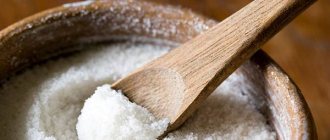I hope that you will like these simple recipes for fermenting vegetables, and that there will always be a place in the refrigerator for not so voluminous jars with healthy preparations.
Almost any food can be fermented: vegetables, fruits, milk, meat, fish, drinks. In recent years, we have become increasingly reminded of the benefits of consuming fermented vegetables, as a tasty and natural way to enrich microflora and strengthen the body’s immune system. The saying is truly true: “The new is the well-forgotten old.”
Basic Fermented Vegetable Recipe
Yield: approximately 1 liter jar
The recipe uses 1 am unit. glass – 236 ml.
Ingredients:
- 2 -3 cups chopped vegetables
- Brine for pouring (1 liter of boiled filtered water, 2 tablespoons of sea salt or coarse rock salt for salting)
- Spices to taste (peppercorns, cumin, garlic, etc.), optional
Preparation:
- Prepare a brine from boiled water and salt. Set aside to cool.
- Transfer the vegetables into a clean (can be sterilized) jar, alternating them with spices.
- Pour in the brine until all the vegetables are covered. Using a spoon or pestle, press down gently to allow air bubbles to escape. You can place a load on top (for example, place a saucer with a bag of cereal or dried beans).
- Cover with a clean cloth or a light lid and leave to ferment at room temperature (18 - 25 degrees C) away from direct sunlight.
- After 3 – 14 days (depending on the desired taste), close the jar with a lid and store it in a cool place. The longer the fermentation process, the more lactobacteria the finished product contains.
List of proven recipes
To prepare fermented vegetables, it is better to use coarse table or sea salt. Small table and iodized ones negatively affect the taste of the product and can even lead to premature spoilage.
The optimal temperature for fermenting vegetables is 21–25 degrees.
Recipe 1. Sauerkraut with cranberries
Sauerkraut is one of the best food sources of vitamin C. The famous navigator James Cook filled wooden barrels with this delicacy, which he then loaded on board the ship before sailing. This is how he protected his team members from scurvy, a serious disease caused by a deficiency of ascorbic acid in the body.
How to make sauerkraut with cranberries at home?
Prepare the following ingredients:
- fresh cabbage – 1 kg;
- half a large carrot;
- cranberries – 80 g;
- salt – 2 tbsp. spoons;
- granulated sugar – 1 tbsp. spoon;
- Bay leaf.
Chop the cabbage and grate the carrots. Stir the vegetables. Rinse and dry the berries. Add salt and sugar to the vegetable mixture.
Prepare a deep container. Place the vegetable mixture on the bottom, sprinkle with 1/3 of the berries, and place a bay leaf in the center. Make 3 more layers like this. Weigh the cabbage down with a plate with a weight (for example, a bag of cereal). Leave the product to ferment at room temperature for 5 days. During this time, foam should appear on the surface.
Make holes in the cabbage all the way to the bottom using wooden sticks. Leave it to ferment for another 5–7 days. Then transfer to a glass jar and store in the refrigerator.
Sauerkraut can last in the cold for 3-4 months.
Recipe 2. Salt-free sauerkraut
Do you want to make sauerkraut without salt? Then try this recipe.
Prepare the following products:
- cabbage (preferably late) – 1 kg;
- one apple;
- one carrot;
- dried dill seeds – 10 g.
Chop the cabbage, grate the peeled apple and carrot on a coarse grater. Mix vegetables, fruits and seeds in one deep container, mash vigorously with your hands until the juice begins to release. It is advisable to use dishes made of acid-resistant material (for example, an enamel pan or stainless steel) for fermentation.
Cover the workpiece with a flat plate with a weight. Leave to ferment at room temperature for 3 days. Place the finished sauerkraut in glass jars and store in the cold. The shelf life will be 1 month.
Recipe 3. Pickled beets
Pickled beets can be made not only for consumption as an independent snack. It makes a very tasty beetroot soup. This soup tastes like something between borscht and cabbage soup.
For the starter you will need the following ingredients:
- beets – 5 pcs. medium size;
- salt – 1 teaspoon;
- water – 500 ml;
- chopped greens (dill, cilantro or parsley) - a quarter cup;
- cumin seeds – 10 g.
Cut the vegetable into slices up to 0.5 cm thick. Pour the cumin seeds into a glass jar. Place beet slices on top.
We recommend: Is it possible to cook with expired kefir? Which kefir is safe, successful recipes
Dissolve salt in hot water. Pour the salted liquid over the beets until it completely covers them. Sprinkle with chopped herbs. Place a weight on top and cover the container with a clean cotton cloth or gauze. Let the beets ferment at room temperature.
After 10–14 days, remove the weight and remove the greens from the jar. Seal the container with a nylon lid and store it in a cool place.
Pickled beets should be consumed within 3–4 months.
Recipe 4. Kimchi
This fermented dish came to us from South Korea, where a large number of physically healthy and slim people live. Kimchi has a sweet and sour taste with spicy notes.
To prepare a Korean dish, you should use the following products:
- Chinese cabbage – 1 pc.;
- carrots – 1 pc.;
- green onions – 100 g;
- pink sea salt – 1 teaspoon;
- soy sauce – ¼ cup;
- garlic – 10 cloves;
- ground ginger – 1 tbsp. spoon;
- small boiled shrimp - 2 tbsp. spoons;
- honey – 1 teaspoon;
- water – 250 ml.
Chop the Chinese cabbage. Dissolve salt in a glass of water. Pour brine over the cabbage and leave in the kitchen for 6 hours.
Grate the carrots on a coarse grater and chop the green onions. Beat the remaining ingredients listed in a blender until smooth. Add carrots, green onions and savory mixture to cabbage and stir to combine.
Press the vegetables down with a weighted plate. Leave to ferment at room temperature. After 3 days, the kimchi will be ready. It can be stored refrigerated for 2 months.
Recipe 5. Pickled cucumbers
Salty and sour pickled cucumbers are an excellent addition to boiled potatoes and meat dishes. And preparing sourdough is very simple.
You will need the following ingredients:
- cucumbers – 1500 g;
- salt – 2.5 tbsp. spoons;
- water – 1500 ml;
- garlic - one head;
- dill - 3 umbrellas;
- horseradish leaves.
Small cucumbers with pimples are more suitable for fermentation. Rinse them and leave them in water for 3 hours. It will remove excess bitterness. Then place the vegetables in a deep saucepan along with the dill and garlic. Top with horseradish leaves. Tamp down the vegetables and herbs with your hands.
Dissolve salt in cold water. Pour brine over cucumbers. Cover them with a weighted flat plate and leave to ferment at room temperature. After 5 days, pickled cucumbers can be eaten or stored for the winter. In the latter case, the vegetables need to be strained, doused with boiling water and placed in glass containers. Pour the brine into a saucepan, put on fire and bring to a boil. Then pour it over the cucumbers and roll up the jars.
Recipe 6. Black garlic
Garlic can be fermented without salt. This product is even suitable for feeding people with diseases of the cardiovascular system and kidneys. Black garlic has a delicate taste, strong aroma and increases the nutritional value of sauces, meat and fish dishes.
For fermentation, you will need a deep container (about 6 liters in volume) and foil.
Place fresh peeled garlic cloves on the bottom. Wrap the container with foil in 3-4 layers and close with a lid. This will prevent bacteria from getting inside. Place the dish with garlic next to the radiator. Fermentation will take about 40 days.
Recipe 7. Pickled sweet peppers
Sweet peppers become juicier after fermentation. Pairs well with meat, pasta, and potatoes. It can also be added to vegetable soups.
For cooking you will need the following products:
- bell pepper – 7 medium-sized pieces;
- garlic – 1 clove;
- salt – 1.5 tbsp. spoons;
- basil – 1 sprig;
- parsley – 1 small bunch;
- pepper (peas);
- water – 1 liter.
Soak the peppers in boiling water for 3 minutes. Place in a glass jar along with the peas and garlic. Boil water with salt, throw in the greens. Pour the cooled brine over the vegetables. Cover the jar with a lid and leave the contents to ferment.
We recommend: How to properly clean crayfish for eating
After 3 days, pierce the bell peppers with a knitting needle. Place a weighted plate on top of the jar. Leave the peppers to ferment for another 4-5 days. It can then be eaten or stored in a cool place. Shelf life – 2 months.
Recipe 8: Fermented Green Beans
The fermented green bean product is not only appetizing, but also filling due to its high protein and dietary fiber content.
The recipe contains the following components:
- young green beans – 0.5 kg;
- garlic – 4 cloves;
- dill - 2 umbrellas;
- salt – 5 tbsp. spoon;
- pepper (peas) – 1 teaspoon;
- ground chili pepper – 1 teaspoon;
- water – 2000 ml.
Dissolve salt in hot water. Place garlic, dill and seasonings at the bottom of a glass jar, and beans on top. Compact the contents with your hands and fill with cooled brine. Cover the containers with cotton cloth and leave to ferment for 5 days.
Store finished sauerkraut beans in the refrigerator for no longer than 1 month.
Recipe 9. Vitamin mixture of fermented vegetables
Another healthy and simple recipe without salt.
Prepare the following ingredients:
- shredded Chinese cabbage - 2 cups;
- shredded red cabbage – 2 cups;
- sweet potatoes – 1 pc.;
- beets – 1 pc.;
- freshly squeezed celery juice – 1 glass;
- garlic – 2 cloves.
Chop potatoes and beets. Place them in jars along with shredded cabbage and garlic cloves (the containers should be compacted to the top). Pour celery juice over vegetables. Press down the contents with weighted plates and cover with a cotton cloth. Leave to ferment at room temperature for 4 days.
Store the prepared mixture of pickled vegetables in the refrigerator for no longer than 3 months.
Recipe 10. Spicy Mediterranean vegetable salad
This dish is often served as a side dish in Mediterranean and Latin American countries.
A mix of pickled vegetables includes the following components:
- hot pepper – 1 pc.;
- carrot – 1 pc.;
- celery – 3 stalks;
- cauliflower or broccoli – 200 g;
- sea salt – 1 tbsp. spoon;
- apple or wine vinegar - 2 tbsp. spoons;
- water – 500 ml.
Dissolve sea salt in hot water. Chop all the vegetables and fill the container to the top with them. Add vinegar to the cooled brine. Fill the contents of the jar with liquid. Press the vegetables down with a weight and cover with a cloth. Leave to ferment for 5 days.
The mixture is stored in the refrigerator for 1 month.
Pickled beets
The process is longer than fermenting cabbage, but worth it.
Yield: approximately 1 liter jar or 2 half-liter jars
Source
Ingredients:
- 500 g beets (4 -5 medium size)
- 1 ½ tsp. cumin seeds
- 1 tsp coarse or kosher salt
- 2 cups boiled cooled water
- ¼ cup whole basil leaves (or other herbs, optional)
Preparation:
- Cut the peeled beets into thin slices (no thicker than 5 mm).
- Place cumin seeds in the bottom of clean fermentation jars and chopped beet slices on top.
- Prepare brine by dissolving salt in water. Pour over the beets until it just covers the beets. If necessary, you can add clean boiled water.
- Place a weight on top so that it fits inside your jar, and all the beets remain covered with liquid. Cover everything on top with a clean cloth.
- Place the jar(s) on a small plate or tray and leave to ferment at room temperature (18 – 25 degrees C) for 7-14 days.
- As fermentation proceeds, a noticeable increase in gas formation will be felt. When the desired taste and spiciness is achieved, remove the weight, close the jar(s) and put it in the refrigerator. If you put in greens, throw them away after a couple of days. Store in the refrigerator for up to 3-4 months.
8Coconut yogurt
Coconut is a great alternative to dairy products. Coconut yogurt has a creamy texture, which makes it possible to prepare all kinds of culinary delights with it. It tastes incredibly sweet, but unlike many sweet dishes, it does not contain an amount of sugar that is harmful to the body. It is thanks to this that such yogurt will be an excellent afternoon snack and will not contribute to an increase in blood sugar.
Kefir latte
Cabbage, pickled with apples and ginger
Yield 1.5 liters
Source rawfoodchef.com
Ingredients:
- 1 medium cabbage, finely shredded or shredded in food processor
- Cabbage leaves for topping
- 2 sour apples
- 1 tsp ginger, grated
- 1 tsp Himalayan salt
Preparation:
- Place the cabbage in a bowl, sprinkle with salt and rub with your hands until enough juice is released.
- Add all other ingredients and mix well.
- Pack the cabbage tightly into a clean glass or ceramic bowl. Cover the top with cabbage leaves, so that they extend beyond the edges of the dish, and there is access to air. Place a saucer with a load on top (a bag of cereal or dried beans). Cover with a clean cloth and place in a dark place to ferment for 3-4 days at room temperature. Transfer the finished cabbage to a glass jar and store in the refrigerator. It is more beneficial to consume it in the first weeks, when it contains more lactobacteria.
Sauerkraut with beets
Yield: approximately 3 cups
Source
Ingredients:
- 3 cups shredded cabbage
- 1 cup grated beets
- ⅛-¼ cup chopped onion (optional, optional)
- 1 tsp coarse salt + additional brine as needed
- Additional spices upon request
- 1 tsp cumin
- 1 tsp grated ginger
- 1 clove garlic, finely chopped
- 1 whole cabbage leaf
Preparation:
- Place shredded cabbage and grated beets in a mixing bowl. There should be about 4 cups in total. Add chopped onion.
- Add salt and rub the mixture well with your hands. Leave for 1 - 2 hours until the cabbage softens and releases juice.
- Transfer the vegetable mixture along with the resulting juice into a thoroughly washed fermentation jar. Press down well with a wooden pestle or non-metallic spoon. Place a cabbage leaf on top and compact again. Cover the jar with a clean cloth or cover it with a lid so that there is access to air.
- Leave to ferment for 24 hours, pressing the cabbage occasionally. After 24 hours, if the liquid in the jar does not cover all the cabbage, then add brine to the desired level. (For brine, boil water in advance. Dissolve 1 teaspoon of salt in 1 glass of cooled boiled water with 1 teaspoon of salt).
- Leave to ferment at room temperature for another 3-4 days, depending on the room temperature. Apply pressure or periodically press on the cabbage to allow the resulting gases to escape. The fermentation process is accompanied by natural gas formation, so there is no need to be afraid of the smell.
- At the end of 4 days, close the lid tightly and put it in the refrigerator for storage. After cooling, both the smell and taste improve.
Benefits of Fermented Foods
Fermented products are popular due to their valuable properties.
- Fermentation causes the breakdown of certain substances - this helps improve digestive processes.
- Fermented foods slow down the aging process.
- For teenagers, eating pickled vegetables helps get rid of age-related skin imperfections.
- Fermented foods contain a large amount of acids, which is useful for losing weight.
- During the fermentation process, probiotics are formed in vegetables, which help with intestinal disorders.
- Sauerkraut contains a large number of useful substances. Regular consumption of such foods increases energy levels due to the vitamin content and helps strengthen the immune system.
Korean pickled vegetables
Source
Ingredients:
- 1 cup chopped carrots
- 1 cup cauliflower florets
- 1 cup shredded Chinese cabbage
- 1 cup shredded red cabbage
- 3 green onions, chopped
- ginger root (about 2.5cm), peeled and NOT finely chopped
- 2 cloves garlic
- 2 ½ tsp. salt
- ¼ tsp. hot pepper (optional)
Preparation:
- Place carrots and all types of cabbage in a bowl, sprinkle with salt and stir. Let stand for half an hour.
- Rinse with cold water and drain in a colander. Mix with remaining ingredients.
- Place in a storage jar, cover tightly with a lid and refrigerate for 2 days.
- On the third day, remove the garlic and ginger from the mixture. You can serve!
Carrot snack with ginger
Source
Ingredients:
- 1–1 ½ kg carrots, cut into circles
- 100-120 g cabbage, shredded
- 1 -2 tbsp. onion, grated
- ¾ cup fresh ginger, grated or dried to taste
- Water
- 1 tbsp. salt
Preparation:
- Dissolve salt in cooled boiled water and add ginger. Mix.
- Mix prepared carrots, cabbage and onions in a bowl. Transfer to a clean fermentation container.
- Pour the prepared brine over the vegetables. Add more water if the vegetables are not completely covered.
- Leave to ferment at room temperature for 3 to 14 days, covering the top with a clean cloth. Once the desired taste and spiciness are achieved, transfer to a storage container and store in a cool place (cellar or refrigerator).
Who should not use fermented foods?
The increased acid content in homemade preparations makes them unsuitable for consumption:
- people suffering from gastritis or chronic ulcers;
- Dishes made from pickled vegetables are contraindicated for hypertension;
- It is better not to consume fermented foods if you have diseases of the gastrointestinal tract;
- contraindications are diseases of the abdominal organs and dysbacteriosis;
- Excessive consumption of fiber, which is rich in pickled vegetables, can cause bloating or increased gas formation.
Fermented Green Beans
This wonderful appetizer is great without vinegar. Due to the preservation of its own enzymes and vitamins, it can be stored for at least a month.
Yield: 2 liter jars
Source
Ingredients:
- 2 liters of water
- 4-6 tbsp. sea salt
- 500 g young green beans
- 2 tbsp. hot pepper or to taste
- 4 cloves garlic, peeled and crushed
- 1 tsp peppercorns
- 2 handfuls of dill, preferably brooms (umbrellas), but you can also use greens
Preparation:
- Prepare brine by dissolving salt in water. Prepare the container.
- Place pepper, garlic and dill into both jars.
- Place the green beans on top - vertically if they are thin and long, or across the ones that are thicker and sliced. Pour in brine, not bringing it to the top of the jar by about 2-3 cm.
- Close with a lid or cover with a cloth on top. Leave to ferment until desired texture and flavor are achieved (at room temperature 17 – 23 degrees away from sunlight). If you close the lid, open it periodically to relieve the pressure inside.
- A few days after fermentation is complete, close the jars with lids and put them in a cool place.
What is fermentation?
This is the process of fermenting food in liquid without air. In the process, beneficial microorganisms are formed, for which an anaerobic environment is important. It does not require oxygen, and sometimes it is even harmful to bacteria and can contribute to their death.
What are the benefits of fermented foods?
- This way you can prepare vegetables, fruits, milk, meat, fish and even drinks. Pickling has been popular since ancient times. It is very useful for the functioning of the gastrointestinal tract and the state of our immunity.
- Wise housewives begin a large-scale “project” of preparations for the cold in the summer, among which fermented vegetables and other fruits occupy not the least place.
- During the fermentation process, under anaerobic conditions, solid components are separated from the liquid. The result is a healthy brine that can be used for home baking.
- The fruits themselves, very tasty and valuable, are very popular among adults and children. They contain a very high percentage of vitamin C and other important substances for the health of the body. Natural enzymes and vitamins are not destroyed in this food.
Important: to avoid harm to your body, start consuming fermented foods only in small quantities, and then gradually increase the dose.
Where to begin?
Prepare thoroughly before your planned event.
- Prepare vegetables, fruits (completely whole, without damage or rotten areas), maybe sourdough. It is important to stock up on coarse salt (although there are recipes without it if you prefer to use as little as possible). Alternatively, use Himalayan pink.
- There are fermenters specially produced by industry. These include, for example, a yogurt maker or a bread fermenter. Every little detail is thought through in the device, including temperature conditions and pressure creation, as well as holes for air outlet.
- Choosing a container is important, because products can be stored there for a long time, and harmful substances should not get into the liquid. Professionals recommend choosing ceramics or glass.
- If you do not use industrial equipment, but decide to ferment vegetables the old fashioned way, then find a form of pressure: a heavy container, some kind of weight to press the vegetables.











